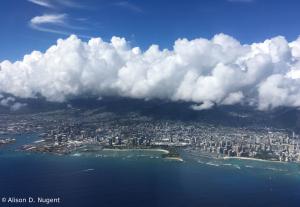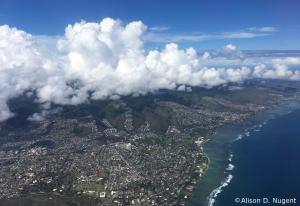UH research shows decrease in humidity over Hawaiian Islands
University of Hawaiʻi at MānoaThe world is experiencing a variety of effects of global warming, and some parts of Hawaiʻi are seeing a decrease in relative humidity. Those are the unexpected results of research recently published by a team including a PhD candidate in the Department of Geography and Environment in the College of Social Sciences.
Aurora Kagawa-Viviani said the University of Hawaiʻi at Mānoa research effort began as a course project to improve air temperature maps for the Hawaiian islands. Drawing on daily temperature records from 309 stations between 1905 and 2017, researchers explored relationships of surface air temperatures to atmospheric, oceanic and land surface variables.
“We knew that global warming was causing temperatures to increase across the islands, but we were surprised to find that nighttime sea-level air temperature has been rising very rapidly, much faster than suggested by trends averaging records from multiple low stations,” said Kagawa-Viviani. “A weaker warming trend in midday temperatures, especially close to the cloud layer, pointed us to atmospheric drying—decreasing relative humidity—in some parts of our island.”
Added co-researcher Thomas Giambelluca, geography and environment professor and director of the UH Water Resources Research Center, “This holds significance for understanding how water resources, ecosystems and human populations are being, and will continue to be affected by, climate change over the next decades. These mapping and analysis efforts are steps toward better understanding how these changes are happening now and into the future.”
The paper was published in the December 2019 issue of the Journal of Geophysical Research: Atmospheres.
To see how spatial patterns of temperature changed over the years, Kagawa-Viviani and Giambelluca derived the statistical relationships between temperature and elevation each year. This allowed them to not only map temperature patterns, but also provided a unique way to estimate sea-level air temperature and examine long-term changes.
“We were surprised that daytime temperatures in the middle elevations were not increasing, or were even decreasing in some areas,” said Kagawa-Viviani. “We initially thought this was an effect of inconsistencies in the data, but it turned out that atmospheric drying below and within the cloud layer, and associated rising of cloud base, explained the lack of warming in the cloud zone.”
Through the process of eliminating alternative explanations and exploring other atmospheric profile datasets, the connection was made between patterns of temperature and humidity change. By summer 2019, the researchers were able to conclude that the pattern of middle elevation cooling was consistent with lower-level drying and upper-level moistening.
Geography and environment graduate students working with Giambelluca will continue to study changes in Hawaiʻi’s climate, to project future changes and to analyze how the changes affect water resources and natural ecosystems in the islands.
Kagawa-Viviani works at the intersection of plant ecology and hydrology, using data from environmental sensors to understand how processes of biotic invasion, ecological restoration and climate change can shape plant communities and water-energy dynamics on the land’s surface.
Her research time was supported by a predoctoral and dissertation fellowship from the Ford Foundation, as well as a graduate assistantship supported by the Honolulu Board of Water Supply.



